Looking for a loyal and lovable companion? Look no further than the Labrador Retriever! With their friendly demeanor and fantastic fetching skills, Labradors are a popular choice for dog lovers everywhere.
But what sets them apart from other breeds? From their origins to their intelligence, this discussion will explore the fascinating information and unique characteristics of the Labrador Retriever.
So, if you're curious to uncover the secrets behind this remarkable breed, prepare to be amazed!
Key Takeaways
- Labrador Retrievers are a friendly, outgoing, and gentle breed known for their friendly temperament.
- They require regular exercise and mental stimulation to stay healthy and happy.
- When looking for a Labrador Retriever, it is important to thoroughly research and choose a reputable breeder who follows ethical practices and prioritizes the well-being of the dogs.
- Alternatively, consider adopting from rescue organizations or shelters to provide a loving home to a dog in need.
Origin and History
The Labrador Retriever breed originated in Newfoundland, Canada, and has a rich history as a versatile and beloved companion. These dogs were initially developed to assist fishermen in retrieving fish that escaped from nets or were caught in the water. Their webbed paws and water-resistant coat made them excellent swimmers, allowing them to perform their tasks efficiently.
Over time, Labradors gained recognition for their exceptional retrieving abilities, loyal nature, and friendly temperament. They became popular among hunters as reliable hunting companions, and their intelligence and trainability also made them valuable as therapy and assistance dogs.
Today, Labradors continue to excel in various roles, including search and rescue operations and participating in dog shows. Their enduring popularity is a testament to their remarkable qualities and their enduring bond with humans.
Size and Weight
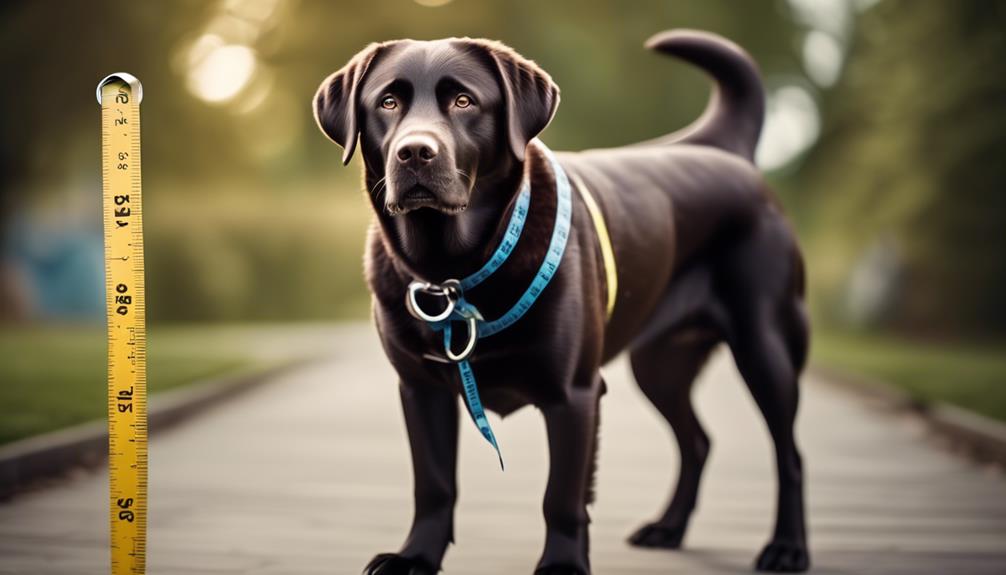
Labrador Retrievers come in various sizes and weights, with males typically weighing between 65-80 pounds (29-36 kg) and females weighing between 55-70 pounds (25-32 kg).
These dogs are known for their sturdy build and muscular physique. Their size and weight make them a versatile breed, capable of performing various tasks such as hunting, retrieving, and assisting humans.
Despite their larger size, Labrador Retrievers are known for their gentle and friendly nature. They're suitable companions for families and are particularly good with children.
Their size also makes them well-suited for various living situations, including apartments, as long as they receive regular exercise and mental stimulation.
Breed Group Classification

As we continue our exploration of Labrador Retrievers, let's now turn our attention to their classification within the breed groups.
Labrador Retrievers belong to the Sporting group, which is one of the seven breed groups recognized by the American Kennel Club (AKC). The Sporting group consists of dogs that were bred for hunting and retrieving game. Labrador Retrievers excel in this role due to their strong swimming abilities, excellent sense of smell, and retrieving instinct.
In addition to their hunting and retrieving skills, Labs are also trained as therapy and assistance dogs, participate in dog shows, and are employed in search and rescue operations.
Their versatility and adaptability make them a valued member of the Sporting group.
Lifespan and Health

When considering the lifespan and health of Labrador Retrievers, it's important to be aware of genetic health issues and the average life expectancy for this breed. Labrador Retrievers are generally a healthy breed, but they're prone to certain genetic health issues.
Common health problems in Labs include hip and elbow dysplasia, which can cause joint pain and mobility issues. They're also susceptible to eye conditions such as cataracts and progressive retinal atrophy. Regular veterinary check-ups and screenings can help detect and manage these conditions early on.
On average, Labrador Retrievers have a lifespan of 10 to 14 years, but with proper care, they can live even longer. Providing a balanced diet, regular exercise, and lots of love and attention can contribute to their overall health and well-being.
Coat Colors and Characteristics

To continue our exploration of Labrador Retrievers, let's now shift our focus to their coat colors and unique characteristics.
Labradors come in three main coat colors: black, chocolate, and yellow. The black coat is the most common and is solid in color. The chocolate coat ranges from light to dark brown and can have variations in shade. The yellow coat can range from light cream to fox red.
Labradors have a short, dense, and water-resistant double coat, which helps protect them in water and cold weather. Their coats require regular brushing to minimize shedding.
Labradors also have webbed toes, which aids in swimming. Their coat colors and characteristics make them not only attractive but also well-adapted to various environments and activities.
Temperament and Personality
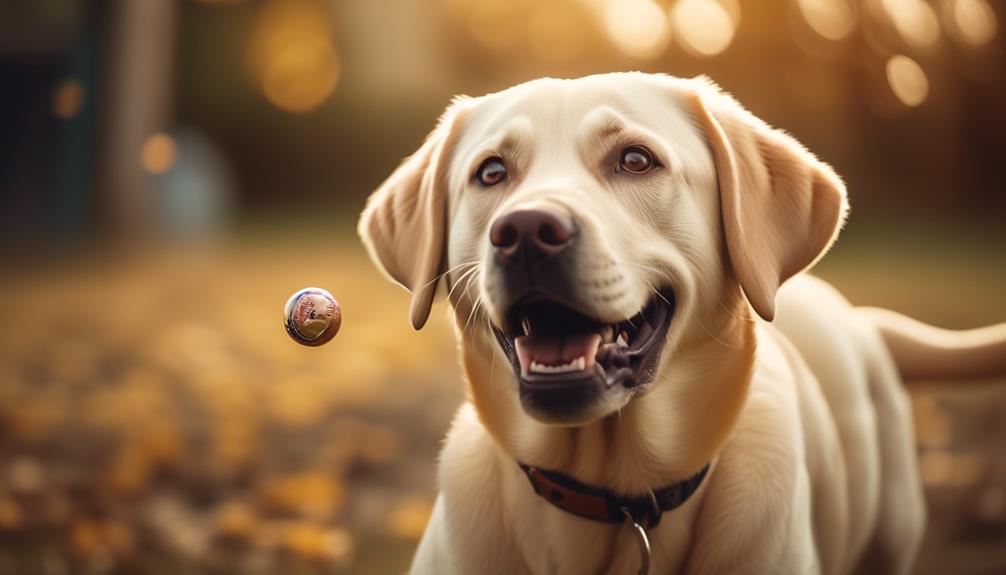
Labrador Retrievers are known for their friendly and outgoing temperament. They've a natural inclination to be social and are generally good with people, including children. Labs are also known to be gentle and patient, making them great family pets.
Here are some key aspects of their temperament and personality:
- Sociable: Labs enjoy being around people and get along well with other dogs and pets.
- Energetic: They've a high energy level and require regular exercise to keep them happy and healthy.
- Intelligent: Labs are highly intelligent and trainable, which makes them suitable for various activities such as obedience training, agility, and search and rescue.
Exercise and Mental Stimulation Needs
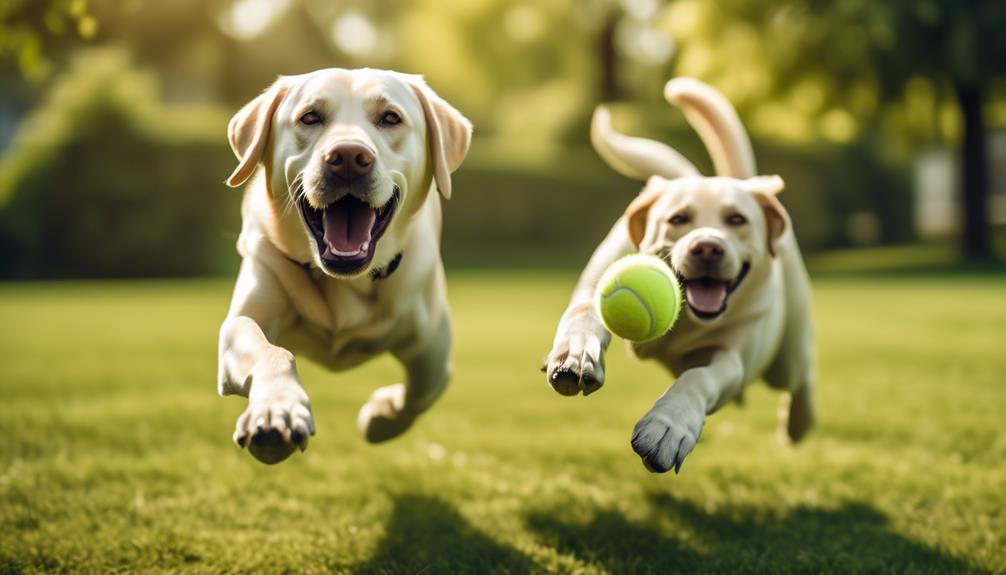
Meeting the exercise and mental stimulation needs of a Labrador Retriever is crucial for their overall well-being and happiness. Labs are energetic and active dogs that require plenty of physical activity to stay healthy. Daily exercise should include long walks, runs, or play sessions in a securely fenced area. Engaging in activities such as swimming, retrieving, or agility training can also help satisfy their need for mental stimulation.
Labs are highly intelligent and enjoy learning new tasks, so providing them with interactive toys and puzzle games can keep their minds engaged. Neglecting their exercise and mental stimulation needs can lead to behavioral problems and frustration. Therefore, it's important to dedicate time and effort to ensure that your Labrador Retriever gets the necessary exercise and mental stimulation to thrive.
Training and Intelligence

Regular training is essential for Labrador Retrievers due to their high intelligence and trainability. These dogs are quick learners and thrive on mental stimulation. Here are three important aspects to consider when training your Labrador Retriever:
- Consistency: Labrador Retrievers respond well to consistent training methods. Establish clear rules and boundaries that are consistently reinforced to help them understand what's expected of them.
- Positive Reinforcement: Use positive reinforcement techniques such as treats, praise, and rewards to motivate and encourage your Labrador Retriever during training sessions. This will help them associate training with positive experiences.
- Socialization: Labrador Retrievers are sociable dogs, and early socialization is crucial to ensure they grow up to be well-rounded and friendly. Expose them to various people, animals, and environments from a young age to help them develop good social skills.
Grooming and Maintenance
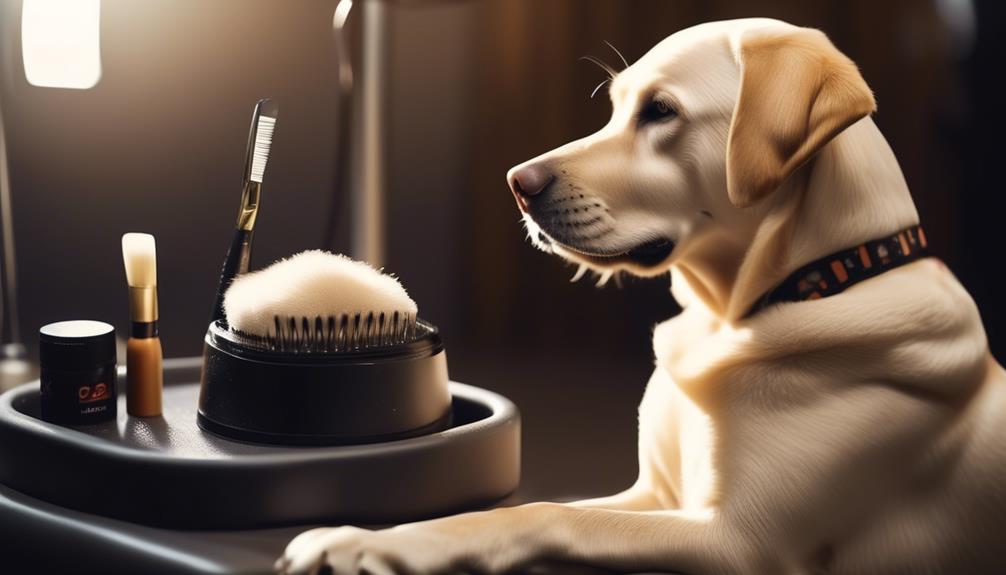
To keep your Labrador Retriever looking their best, regular grooming and maintenance are important. Labs have a short, dense coat that requires minimal grooming. However, they do shed, especially during seasonal changes, so regular brushing can help minimize shedding and keep their coat healthy. Use a slicker brush or a grooming mitt to remove loose hair and prevent matting.
Additionally, Labs are prone to ear infections, so it's crucial to check their ears regularly and clean them as needed. Trim their nails every few weeks to prevent them from becoming too long and causing discomfort.
Bathing should be done on an as-needed basis, using a gentle dog shampoo. Lastly, don't forget to brush their teeth regularly to maintain good oral hygiene.
With proper grooming and maintenance, your Labrador Retriever will always look and feel their best.
Finding a Reputable Breeder
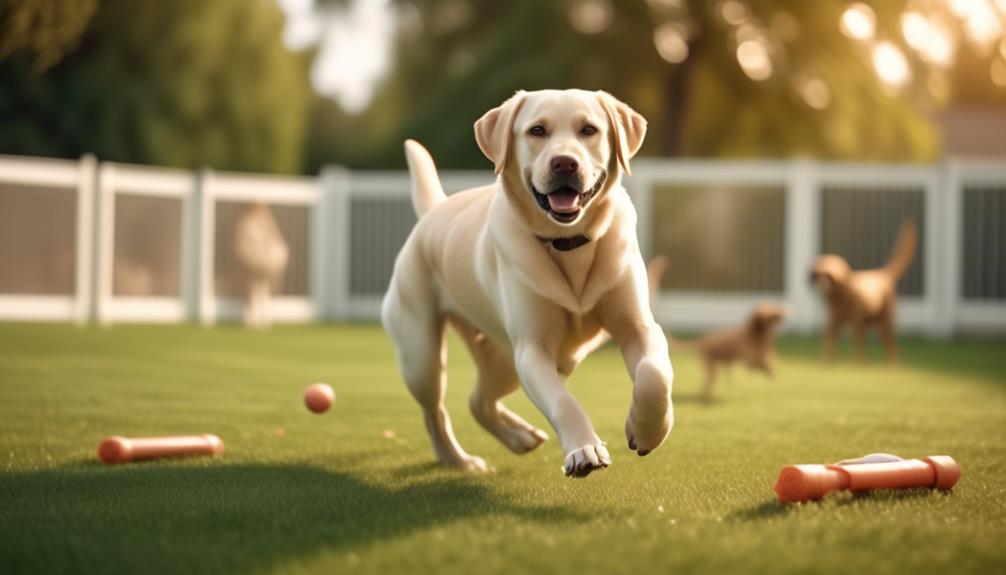
When considering adding a Labrador Retriever to your family, it's essential to know how to find a reputable breeder for your new furry companion. To ensure you find a breeder who prioritizes the well-being of their dogs, follow these steps:
- Thoroughly research and choose a reputable breeder.
- Ensure the breeder follows ethical practices and values dog well-being.
- Look for breeders who conduct necessary health screenings for their dogs.
Adoption and Responsible Ownership

Consider adopting a Labrador Retriever from a rescue organization or shelter to provide a loving home to a dog in need. Adoption is a great way to contribute to responsible ownership and make a positive impact on a dog's life. By adopting, you give a Labrador Retriever a second chance at happiness and a forever home. To give you a better understanding of the benefits of adoption, take a look at the table below:
| Benefits of Adoption | ||
|---|---|---|
| 1. Save a life | 2. Provide a loving home | 3. Support animal welfare organizations |
Adopting a Labrador Retriever not only brings joy to your home but also helps alleviate the burden on overcrowded shelters and rescue organizations. Remember, responsible ownership begins with adoption!
Frequently Asked Questions
What Are Some Common Health Issues That Labrador Retrievers May Face?
Labrador Retrievers may face common health issues such as hip and elbow dysplasia, as well as eye conditions. Regular health screenings by a reputable breeder can help identify and address these concerns.
Are Labrador Retrievers Good With Children and Other Pets?
Yes, Labrador Retrievers are typically good with children and other pets. They are friendly and gentle, making them great family dogs. However, it's important to socialize them properly and supervise interactions for safety.
How Much Exercise Does a Labrador Retriever Need on a Daily Basis?
Labrador Retrievers need a good amount of exercise on a daily basis. They are active dogs that thrive with regular physical activity. Aim for at least an hour of exercise to keep them happy and healthy.
Are Labrador Retrievers Prone to Excessive Shedding?
Labrador Retrievers are not excessive shedders. Their short, dense coat sheds moderately throughout the year. Regular brushing helps to control shedding.
Can Labrador Retrievers Be Left Alone for Long Periods of Time?
Yes, Labrador Retrievers can be left alone for long periods of time, but it's not ideal. They thrive on human companionship and may develop separation anxiety. Providing mental stimulation and exercise is crucial.
What are the similarities and differences between Labrador Retrievers and Huskydoodles in terms of breed characteristics?
Labrador Retrievers and Huskydoodles are both friendly and popular dog breeds. While Labradors are known for their loyalty and obedience, Huskydoodles are a mix of playful Huskies and intelligent Poodles, making them great family pets. However, both breeds require regular exercise and grooming to stay healthy. For more huskydoodle dog breed information, consult a reputable breeder or veterinarian.
Conclusion
In conclusion, if you're looking for a dog that's friendly, intelligent, and adaptable, the Labrador Retriever is the perfect choice.
With their gentle temperament and versatility in various activities, they make great companions for both experienced and novice dog owners.
Their low maintenance grooming needs and trainability make them a practical choice for busy individuals.
Whether you choose to adopt or purchase from a reputable breeder, a Labrador Retriever will bring joy and love into your life for years to come.




